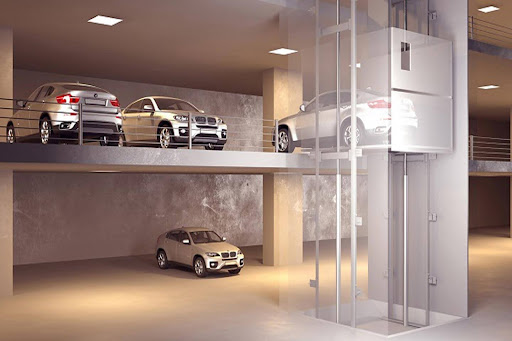Car lift lifts are a growingly common solution for optimizing space in residential buildings, business complexes, or automotive facilities. Specialized vehicle transport elevators function to move cars between floors thus solving the problems of limited land supply in urban areas. The range of car lifts will become more understandable to you if you run a building development company or manage commercial facilities or private residences that need additional parking space. The post that follows different car lift elevator types will help you select an option that perfectly matches your individual needs.
Hydraulic Lift Elevators for Cars
For vertical vehicle transfer, one of the most popular options is a hydraulic car lift. The hydraulic fluid pressure produced by a pump drives a piston in these systems, raising the platform that holds the vehicle. This pressure is gradually released during the descent, enabling a fluid downward motion.
Hydraulic car lift elevators are quite popular since they are dependable, simple to use, and need less money to install initially than other options. They perform exceptionally well in low- to mid-rise applications, usually providing efficient service for buildings with two to five stories. These systems may be installed with flexibility because the power unit that powers them can be placed in different places.
In residential situations where quieter operation is desired, hydraulic systems are appropriate since they operate steadily and produce little noise. They can effortlessly lift both normal passenger cars and even larger SUVs or luxury cars because of their remarkable lifting capabilities. Hydraulic systems require additional energy input to operate thus affecting the long-term expenses.
Hydraulic car lifts require regular maintenance to stop fluid leakage and protect the hydraulic elements from damage. These systems present a smart investment choice to property owners who want to enhance parking spaces since their expected lifespan with proper upkeep can span multiple years.
Systems of puzzles and stackers
In congested metropolitan settings, puzzle and stacker car lift elevators provide creative solutions that significantly expand parking capacity in constrained spaces. To optimize space use, these systems use both horizontal and vertical movement to arrange vehicles in configurations akin to three-dimensional puzzles.
Multiple platforms that can move both horizontally and vertically are commonly found in puzzle systems, allowing cars to be positioned in suitable areas and retrieved when necessary. Unlike traditional parking structures, which require drive lanes and ramps, these advanced car lifts can double or even treble a parking area’s capacity.
Stacker systems are a condensed form of this idea that mainly concentrates on the vertical placement of cars in a set position. These car lift elevators essentially enhance the parking capacity of a single place by the number of floors in the system by stacking automobiles directly over one another.
With some more sophisticated models functioning as completely automated parking solutions, both puzzle and stacker systems typically include automated controls for vehicle retrieval. The system takes care of everything; users only need to drop off their automobile at a specified transfer location, and it will return it there upon request.
These advanced car lifts make the most use of available space, but they are more expensive initially and require more complicated maintenance. They are especially useful in crowded cities where the expense of land justifies the expenditure for parking options that save space.
Home Use Vehicle Lift Elevators
A growing number of homeowners are using car lift elevators to solve parking issues in their homes. Residential car lifts provide useful private-use solutions for urban townhouses with restricted street parking, luxury residences where displaying car collections is preferred, and multigenerational households with numerous vehicles.
Compared to commercial systems, residential systems tend to be quieter, have simpler control interfaces, and integrate more aesthetically with the architecture of the house. In addition to fitting particular car specifications, they frequently have platform sizes and finishes that may be altered to match the style of the house.
In residential car lift elevators, safety elements are given special consideration. Multiple redundant systems ensure secure operation, even when family members without technical experience use them. These could include backup power systems to keep cars from becoming stranded during power outages, emergency stop features, and platform sensors that stop operations if impediments are detected.
Careful planning is necessary to accommodate structural requirements and access considerations when installing in existing residences. Many homeowners choose systems that can be hidden completely or partially when not in use, preserving the aesthetics of the property while offering the convenience of more parking space.
Connectivity to Passenger Access
The need for solutions that can accommodate both people and cars in many modern structures has led to integrated systems that combine car lift elevators with passenger lifts. Cars and their occupants can go through multi-level buildings safely and conveniently thanks to these hybrid systems.
In a residential context, this may entail a car lift that permits drivers to stay in their cars while being transported, equipped with the same safety features and cabin comforts as conventional passenger lifts. With adjacent passenger elevators for people and specialized car lifts for cars, commercial applications frequently divide these roles and link them with well-planned transition zones.
Clear operating procedures, frequently more advanced control systems, and close adherence to safety regulations are necessary for the integration of vehicles and passenger lifts. Both on foot and in cars, building inhabitants may move between levels with ease thanks to these integrated systems, which also improve user convenience while preserving security.
Conclusion:
Every car lift elevator purchase demands consideration of specific requirements which include building construction characteristics and traffic patterns together with financial resources and the allocated space availability. By understanding the unique advantages of traction and hydraulic systems together with scissor lifts and puzzle systems you can ensure contentment with your purchasing decision.
The importance of car lifts in contemporary building design and retrofitting projects will only grow as urban spaces continue to change and the value placed on efficient land use rises. By making the most of the available space, these solutions not only solve real-world parking issues but also support more environmentally friendly urban growth.
You may choose a system that will deliver dependable service for many years to come by navigating the available options and seeking advice from knowledgeable professionals who can evaluate your unique demands and structural issues when planning for a car lift elevator installation.



